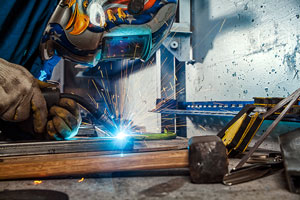One of the biggest and most important industries in the United States and worldwide is also one of the most misunderstood.
Construction is vital to our infrastructure. Without construction, we wouldn’t have homes, roads, stores, schools, factories or hospitals. We wouldn’t have running water, electricity, or air conditioning.
Truly, everything begins with construction.
But despite the major role construction plays in society, the industry has been marginalized. Long-standing stereotypes contribute to a poor public attitude toward construction, while the push for four-year degrees has placed craft careers in a perceived lower tier of work.
We’re here to bust a few myths. Here are the top 5 misconceptions about construction – and the reality you need to know.
Construction is often thrown into the category of unskilled labor – work that doesn’t require any special training or knowledge to do.
This attitude likely stems from the fact that someone doesn’t need a college degree to get a construction job. In much of society’s mindset, a job that requires a degree equals skilled labor; anything else is unskilled labor.
However, in many ways construction work requires even sharper skills than an office job.
After all, the areas of concentration in construction are known as crafts. Craft professionals aren’t merely doing hard, mindless labor – they’re performing detailed, specialized work that requires a high level of talent.

The crafts combine art and science. Construction pros need to be able to pair creativity and a keen eye with precision and meticulous detail.
For example, architects are responsible for designing beautiful, iconic and eye-catching buildings while also considering structural support, code requirements and general functionality.
Welding offers another great example. A welder needs the steady hand of an artist while applying a knowledge of things such as metallurgy, geometry and oxidation.
The average person can’t jump right in and operate heavy machinery or repair an HVAC unit or lay miles of pipes and wiring. Construction requires a high level of specialized skill which is only obtained through training and experience.
Just like with the misperceptions about the skill required to work in construction, many people believe construction is for the uneducated.
Drop out of high school? Work in construction. Didn’t get into college? Work in construction.
The prevailing thoughts around construction are that it’s what you do if you’re not smart enough to do anything else.
The truth is, though, that construction requires a lot of education!
In order to be able to do jobs safely and correctly, beginning craftspeople go through several years of training. Those skills mentioned in the previous section don’t come out of nowhere; they are earned through learning, practice and experience.
It makes sense: You wouldn’t want to live, work or play in a building built by people who didn’t know what they were doing!

Construction education comes in several forms. One of the most beneficial, yet underutilized ones is apprenticeship programs.
In an apprenticeship, students learn from experienced professionals and put their new knowledge into practice on an actual job site. Apprenticeships have a few key advantages:
Along with apprenticeships, students can also get educated in the crafts through more classroom-oriented settings, including community colleges and universities. Community colleges often offer advanced CTE programs, while university education can set up someone to work in managerial or business roles with a construction company.
Aspiring craft professionals can also teach themselves. For example, NCCER craft training materials can be bought by individuals, who can go through the program and assessments independently on their way to earning industry credentials.
Although construction education may not feature much gen-ed learning, the more focused curricula helps young people enter the workforce faster, better prepared for the job, and with little to no debt. Now that’s a smart choice!
When many people think of construction, they think of something like Extreme Makeover: Home Edition or one of the many renovation shows on HGTV.
While these television programs do indeed showcase construction, the field extends far beyond residential work.
Construction has three main branches: Residential, Commercial and Industrial.
Residential construction includes houses and apartment buildings. Commercial construction includes shops, restaurants, office buildings, stadiums and many more. Industrial construction includes factories and manufacturing plants.
There are also numerous construction disciplines that cross over or fill gaps between the three branches. Roads and energy facilities are some examples of this.
You benefit from the fruits of many different types of construction on a daily basis. You wouldn’t be reading this page without the electricians who wired the system that charged your phone or powered your computer. The water you drank or the shower you took today wouldn’t have happened without the piping placed and maintained by plumbers and pipefitters.
So remember: Construction is more than just building houses.
The bright yellow or orange “Men at Work” sign is an iconic image associated with the construction industry. But are those signs still accurate?
Not exactly.
For most of history, men dominated the world of construction. The natural physical differences between the average male and female played a big role in this, as bigger and stronger bodies were often needed for certain tasks.
However, improved technology and safety capabilities have made these physical traits less important. Now the construction industry needs anybody with the right craft skills, regardless of who or what they are.
Women can become welders, carpenters, electricians, plumbers, and just about every other type of craft professional.
While the majority of craftspeople are still men, the number of women entering the industry is rising. And with the growing labor shortage in the construction industry, recruiting women is more important than ever.

The wage gap is a big topic in the U.S. economy. Some studies show that women earn only 80 cents for every dollar a man earns.
However, this wage gap is significantly smaller in the construction industry. The U.S. Bureau of Labor Statistics report that women earn 97 cents to the dollar in construction, much better than the national average.
While there is still work to do, the high demand and the concentration on hard skills makes the construction industry a very lucrative financial option for women pursuing a career.
Expect to see more “Men AND Women at Work” signs posted at construction sites in the near future.
Fears over safety often cause young people and their parents to rule out that career path automatically.
Even after hearing of the many benefits of a career in construction, the thought standing or eating lunch on a steel beam 100 stories in the air is a familiar route for the mind to take.

Cartoon hijinks atop construction sites, such as this scene from the Tom and Jerry episode “Penthouse Mouse,” help form the basis of fears about safety in construction.
While construction naturally has its dangers, the industry has been committed to making worksites safer for workers.
Thanks to numerous factors, working in construction is safer than ever before:
It’s true that jobs involving heavy machinery, power tools and large components will always have more risks than sitting in a swivel chair in front of a desk. But the construction industry has made incredible strides in recent years to minimize these risks and create a safe and healthy work environment for craft professionals.
There are a lot of misconceptions about the construction industry. So what are the facts about construction and the craft labor market?
Click here to learn the info you need to know about construction.